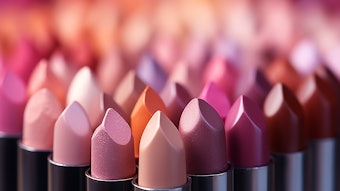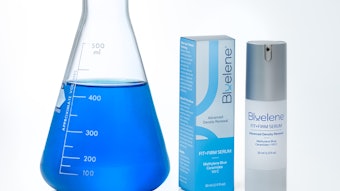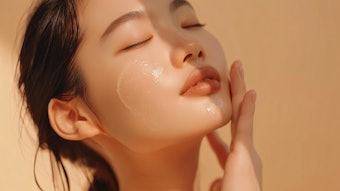Editor's note: This is the edited version of an article that originally appeared in the November 2012 issue of Skin Inc. magazine. All rights reserved.
Fighting the visible signs of aging is a lifelong pursuit for many. Others have given up, assuming that it’s a pointless effort because it’s based on genetics. But only 10–15% of cutaneous aging is actually driven by genetics or the passage of time. This intrinsic, inevitable aging is not where beauty brands' focus should rest. The true culprit is extrinsic aging, caused by external influences, as 85–90% of all cutaneous aging is a direct result of these avoidable factors.1
The Anatomy
The majority of a healthy dermis is the extracellular matrix (ECM), a complex framework of biomolecules designed to support and protect the dermal cells. The structural proteins (collagen and elastin), adhesive proteins (laminins and fibronectin), glycosaminoglycans (GAG) and proteoglycans that comprise the ECM do degrade naturally due to intrinsic aging, but this breakdown is dramatically accelerated by external offenders—primarily UV exposure and the resultant oxidative stress, and the increase in matrix metalloproteinase (MMP) activity.2 Study after study confirms the fact that unnecessary sun exposure is the No. 1 culprit in extrinsic aging.
Broad-spectrum UV Protection
Sun exposure is the worst of the exogenous causes of skin aging. As little as 0.1 minimal erythema dose—the minimum dose of radiation that produces skin redness—will increase the expression of MMP.3 These MMP accelerate matrix breakdown, leading to varying degrees of visible sagging and laxity, wrinkles, epidermal and dermal atrophy, and enlargement of pores.
Because sunscreens can limit UV-induced skin damage and MMP production, they are often accepted as the most beneficial anti-aging products available today.4 It is important to understand the variety of ingredients available to make informed decisions regarding the effective development and use of sunscreen.
Sunscreen can have either chemical or physical ingredients, or a combination of both. It is critical for skin health and anti-aging benefits that the sunscreen product protects against both UVB and UVA wavelengths. UVA rays have a longer wavelength, giving them the ability to penetrate into the dermis and break down the ECM. Currently, only four of the ingredients approved by the U.S. Food and Drug Administration (FDA) provide true broad UVA spectrum protection: zinc oxide, titanium dioxide, avobenzone and ecamsule. For this reason, a true broad-spectrum sunscreen should include one of those four components, in addition to UVB-protecting ingredients. Typically, a blend of multiple ingredients is necessary to provide truly efficacious sunscreen protection.
To provide protection against the UV-induced oxidative stress put on the skin, topical antioxidants should also be used regularly in all regimens. Look for sunscreens that also include antioxidants or other topical agents that can deliver several multifunctional antioxidants. Some important antioxidants to include are epigallocatechin gallate (EGCG) and other green tea components, resveratrol, ergothioneine, caffeine, silymarin and genestein. Also consider adding an antioxidant serum to clients’ morning regimen with ingredients such as vitamins C and E.
Smoking and the Skin
Another important lifestyle consideration that dramatically affects the skin is smoking. In a study compiled by the Campaign for Tobacco-Free Kids during the fourth quarter of 2010, 46.6 million U.S. adults and 3.4 million high school students regularly smoke cigarettes. Despite efforts to educate children about the health hazards linked to smoking, 1,000 children become regular smokers each and every day. The negative effects on the cardiovascular system and the lungs are widely recognized, but many who choose to smoke have little or no awareness of what smoking does to healthy skin. Smoking is a major contributor to many skin conditions and complications, such as skin discoloration, ECM breakdown, deep wrinkling, premature skin aging, poor wound-healing and the formation of abnormal skin growths.
The nicotine in cigarette smoke causes vasoconstriction (blood vessel contraction). In addition, the carbon monoxide in cigarette smoke bonds with oxygen in the blood, restricting the amount of oxygen delivered to the body. This deadly combination of nicotine and carbon monoxide not only constricts capillaries trying to carry oxygen, but also reduces the availability of oxygen to flow through them.
Smoking just one cigarette restricts blood flow for up to 90 minutes. During this 90-minute period, the amount of oxygen that is available to pass through the skin is dramatically reduced. If a person smokes more than one cigarette during this 90 minutes, then the time the skin goes without proper oxygenation is multiplied exponentially. The telangiectasias—small, dilated blood vessels near the skin’s surface—that are characteristic of a smoker’s skin are a result of the body attempting to get more blood to the skin by producing more vessels. In addition to the vascular effects on the skin, exposure to the pollutants present in cigarettes accelerates the degradation of the ECM by increasing MMP—specifically MMP-1—production, causing the unwanted breakdown of healthy and necessary matrix components, such as collagen and elastin, leading to wrinkling and laxity.
It is important to be certain consumer are educated on the realities of what you can achieve with their skin if they continue with their habit. Similar to consumers with hyperpigmentation who insists on continuing to lie in the sun, treating for sallow, deoxygenated, telagiectatic skin when they continue to smoke is futile. Any forward progress that you make will be sabotaged by the nicotine and carbon monoxide that continue to barrage the skin. Once someone has quit smoking, professional detoxifying and oxygenating treatments can promote increased circulation and oxygenation of the skin cells. These types of treatments, as well as superficial chemical peels, can make an impressive visible improvement in skin tone. In addition, consider adding L-ascorbic acid, retinoids and peptides to a past smoker’s regimen to increase collagen deposition and help reduce wrinkling. Some ingredients, such as capparenols from caper bud and certain types of algae, can support and strengthen capillaries to reduce their hyperpermeability.
A Good Night’s Sleep
Another contributing factor in extrinsic aging is based on sleep. Although proper sleep, or the lack thereof, has been cited as the cause of many health issues, it is rarely discussed as an important part of keeping skin healthy and youthful. During sleep, the nervous system shifts from the sympathetic system that is dominant during waking hours to the parasympathetic system. The parasympathetic system increases blood flow to the skin, allowing it to repair and restore itself more effectively.5 It has also been noted that those who have a high rate of alcohol intake have disturbed parasympathetic activity and poor sleep quality.6 So, excessive alcohol consumption not only dehydrates the skin, but also reduces the amount of oxygenation and restoration the skin can perform during quality hours of sleep.
Helping to ensure consumers get their eight hours is important to good health in general. Of course, a good night’s sleep isn’t enough on its own, but it is the easiest and least expensive way to fight extrinsic aging and will help support other ongoing protective and corrective efforts.
Knowing that the vast majority of cutaneous aging is external, prevention should be your first line of defense, as well as your consumers’. Daily use of broad-spectrum sunscreen is an imperative first step in fighting extrinsic aging. Regular chemical peels and other types of professional treatments can help to keep surface texture at its best, stimulate collagen and elastin deposition, reduce skin discoloration and lead to overall healthy skin. With the right lifestyle choices, beauty products and professional treatments, together you can make a difference. Educate consumers on the importance of compliance with their specified regimens, and empower them to know that looking younger and healthier is within their control.
References
- J Herschtal and J Kaufman, Cutaneous aging: A review of the process and topical therapies, Expert Review of Dermatology 2 753–761 (2007)
- G Fisher, S Kang, et al., Mechanisms of Photoaging and Chronological Skin Aging, Archives of Dermatology 138 1462–1470 (2002)
- GJ Fisher, ZQ Wang, et al., Molecular basis of sun-induced premature skin aging and retinoid antagonism, Nature 379 335–339 (1996)
- ZD Draelos, Active agents in common skin care products, Plast Reconstr Surg 125 719–24 (2010)
- www.sharecare.com/question/how-does-sleep-affect-skin (Accessed Sept 7, 2012)
- www.sciencedaily.com/releases/2011/08/110815162220.htm (Accessed Sept 7, 2012)
Jennifer Linder, MD, is a dermatologist and Mohs micrographic skin surgeon, serving as CSO for PCA Skin. She holds a clinical faculty position in the department of dermatology at the University of California, San Francisco; is a spokesperson for The Skin Cancer Foundation; and is a member of the American Academy of Dermatology (AAD), the American Society for Dermatologic Surgery (ASDS) and the American College of Mohs Micrographic Surgery and Cutaneous Oncology (ACMMSCO).










